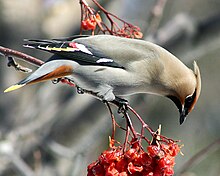| Waxwings | |
|---|---|

| |
| Bohemian waxwing (Bombycilla garrulus) | |
| Scientific classification | |
| Domain: | Eukaryota |
| Kingdom: | Animalia |
| Phylum: | Chordata |
| Class: | Aves |
| Order: | Passeriformes |
| Superfamily: | Bombycilloidea |
| Family: | Bombycillidae Swainson, 1831 |
| Genus: | Bombycilla Vieillot, 1808 |
| Type species | |
| Bombycilla cedrorum | |
| Species | |
The waxwings are three species of passerine birds classified in the genus Bombycilla. They are pinkish-brown and pale grey with distinctive smooth plumage in which many body feathers are not individually visible, a black and white eyestripe, a crest, a square-cut tail and pointed wings. Some of the wing feathers have red tips, the resemblance of which to sealing wax gives these birds their common name. According to most authorities, this is the only genus placed in the family Bombycillidae, although sometimes the family is extended to include related taxa that are more usually included in separate families: silky flycatchers (Ptiliogonatidae (e.g. Phainoptila)), Hypocolius (Hypocoliidae), Hylocitrea (Hylocitreidae), palmchats (Dulidae) and the Hawaiian honeyeaters (Mohoidae). There are three species: the Bohemian waxwing (B. garrulus), the Japanese waxwing (B. japonica) and the cedar waxwing (B. cedrorum).
Waxwings are not long-distance migrants, but move nomadically outside the breeding season. Waxwings mostly feed on fruit, but at times of year when fruits are unavailable they feed on sap, buds, flowers and insects. They catch insects by gleaning through foliage or in mid-air. They often nest near water, the female building a loose nest at the fork of a branch, well away from the trunk of the tree. She also incubates the eggs, the male bringing her food to the nest, and both sexes help rear the young. Waxwings appear in art and have been mentioned in literature.